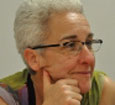Isabel Bravo
Scientist
e-mail: isabel.bravo@ieo.es
I have been working on issues related to toxic or harmful phytoplankton for more than 30 years, covering topics from ecology of harmful algal blooms, toxinology in benthic communities and life cycle of dinoflagellates. I started my professional career with the responsibility of establishing the microalgae culture collection of the Vigo Oceanographic Center, which constitutes the current collection of more than 300 strains (CCVIEO), and of which today I am responsible. I presented the thesis: Study of the toxicity of the sea ear (Haliotis tuberculata) on the Galician coast, with special interest in its cytohistochemical location. Nowdays, I am focused on the study of Gambierdiscus autoecology and on the reproductive processes of dinoflagellates: the elucidation of the models of cell cycles involved in life cycles, sexuality processes and the study of dinoflagellate cysts.
Publications from the last 10 years:
- Bravo I, Figueroa RI, Fraga S. Cellular and nuclear morphological variability within a single species of the toxigenic dinoflagellate genus Gambierdiscus: Relationship to life-cycle processes.Harmful Algae, 40: 1–8. 2014. http://dx.doi.org/10.1016/j.hal.2014.09.009.
- Figueroa, R. I., Dapena, C., Bravo, I., Cuadrado, A.. The hidden sexuality of dinoflagellates: an example of overlooked sex in a facultatively sexual system. PLoSONE. 10(11): 1-21, 2015. http://dx.doi:10.1371/journal.pone.0142667.
- Turon M, Alacid E, Figueroa R I, Reñé A, Ferrera I, Bravo I, Ramilo I, Garcés Esther. Genetic and phenotypic diversity characterization of natural populations of the parasitoid Parvilucifera sinerae. Aquatic Microabial Ecology 76: 117–132, 2015. http://dx.doi:10.3354/ame01771.
- Fraga S, Rodrıguez F, Riobo P, Bravo I. Gambierdiscus balechii nov (Dinophyceae), a new benthic toxic dinoflagellate from the Celebes Sea (SW Pacific Ocean). Harmful Algae 98: 93-105. 2016. http://dx.doi.org/10.1016/j.hal.2016.06.004.
- Rodríguez F, Fraga S, Ramilo I, Rial P, Figueroa RI, Riobó P, Bravo I. Canary Islands (NE Atlantic) as a biodiversity ‘hotspot’ of Gambierdiscus: Implications for future trends of ciguatera in the area. Harmful Algae 67: 131–143. https://doi.org/10.1016/j.hal.2017.06.009.
- Salgado P, Figueroa RI, Ramilo I, Bravo I. The life history of the toxic marine dinoflagellate Protoceratium reticulatum (Gonyaulacales) in culture. Harmful Algae 68: 67–81. http://dx.doi.org/10.1016/j.hal.2017.07.008.
- Salgado P, Fraga S, Rodríguez F, Bravo I. Benthic flattened cells of the phylogenetically related marine dinoflagellates Protoceratium reticulatum and Ceratocorys mariaovidiorum (Gonyaulacales): a new type of cyst? Journal of Phycology, 54, 138–149. https://doi.org/10.1111/jpy.12611.
- Salgado P, Fraga S, Rodríguez F, Riobó P, Bravo I. Ceratocorys mariaovidiorum sp. nov. (Gonyaulacales), a new dinoflagellate species previously reported as Protoceratium reticulatum. Journal of Phycology, 54, 126–137. https://doi.org/10.1111/jpy.12609.
- Díaz PA, Reguera B, Moita T, Bravo I, Ruiz-Villarreal M, Fraga S. 2019. Mesoscale Dynamics and Niche Segregation of Two Dinophysis Species in Galician-Portuguese Coastal Waters. Toxins, 11, 37. https://doi.org/10.3390/toxins11010037.
- Fagín E, Bravo I, Garrido JL, Rodríguez F, Figueroa RI. 2019. Scrippsiella acuminata versus Scrippsiella ramonii: A cell and life cycle comparison. Cytometry Part A 2019, 1-12. https://doi.org/10.1002/cyto.a.23849.
- Bravo I, Rodriguez F, Ramilo I, Rial P, Fraga S. 2019. Ciguatera-Causing Dinoflagellate Gambierdiscus spp. (Dinophyceae) in a Subtropical Region of North Atlantic Ocean (Canary Islands): Morphological Characterization and Biogeography. Toxins 11 (7), 1-17. https://doi.org/10.3390/toxins11070423.
The updated list of all publications is available at the following links:
https://orcid.org/0000-0003-3764-745X
https://publons.com/researcher/2739494/isabel-bravo/publications/
https://www.scopus.com/authid/detail.uri?authorId=56962731600

